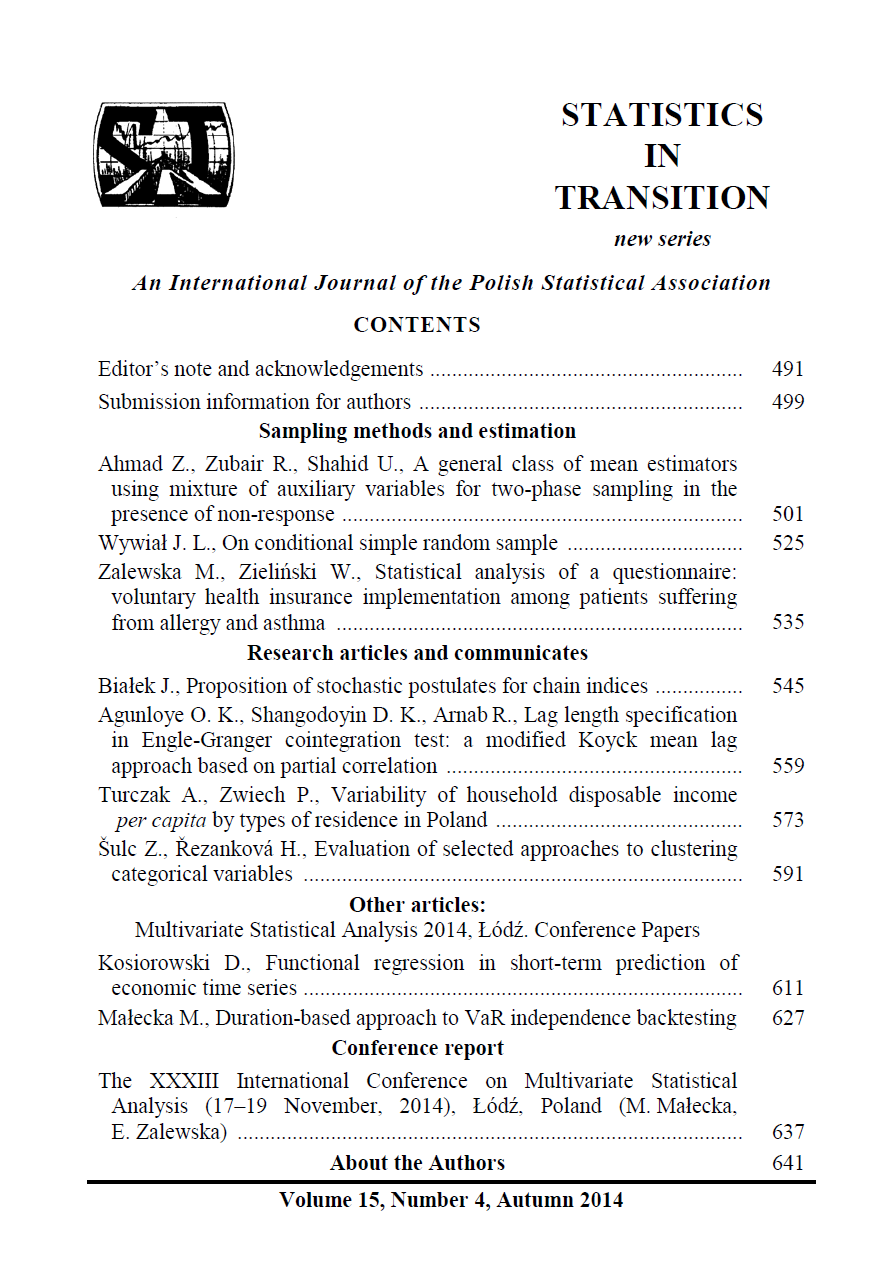ARTICLE
ABSTRACT
The dispersion of household disposable income per capita in each class of residence (i.e. six) was estimated for households in Poland. Then, the dispersion of income between the classes was analysed. The computation was carried out separately for subsequent years from 1998 to 2012. The study shows that the households in Poland are differentiated with regard to income per capita by types of residence, however, the differences within the groups are much bigger than the differences between the groups. What is particularly surprising, the share of between-group variance in total variance in the population under study was negligible small (just a few percent) compared to the share of the mean within-group variance (more than 90 percent).
KEYWORDS
disposable income per capita, type of residence, within-group and between-group variance
REFERENCES
ACZEL, A. D., (2005). Statystyka w zarządzaniu, [Statistics in management], PWN, Warsaw.
BAL, I., (2012). Marginalizacja i wykluczenie społeczne jako bariera rozwoju regionalnego, [The marginalization and the social exclusion of people as a reason for stopping regional development], Nierówności społeczne a wzrost gospodarczy 28, [Social Inequalities and Economic Rise], Wydawnictwo Uniwersytetu Rzeszowskiego, Rzeszów.
BARTAK, J., (2014). Uwarunkowania redukcji nierówności dochodowych w Polsce, [Determinants of the reduction of income inequalities in Poland], Nierówności społeczne a wzrost gospodarczy 37, [Social Inequalities and Economic Rise], Wydawnictwo Uniwersytetu Rzeszowskiego, Rzeszów.
BIELECKA, A., (2001). Statystyka w zarządzaniu. Opis statystyczny, [Statistics in management. Statistical description], Wyższa Szkoła Przedsiębiorczości i Zarządzania im. Leona Koźmińskiego w Warszawie, Warsaw.
Budżety gospodarstw domowych w 2012 r., [Household budget survey in 2012], (2013). Central Statistical Office of Poland, Warsaw.
BUGA, J., KASSYK-ROKICKA, H., (2008). Podstawy statystyki opisowej, [Basics of descriptive statistics], Wyższa Szkoła Finansów i Zarządzania w Warszawie, Warsaw.
Eurostat database: http://appsso.eurostat.ec.europa.eu/nui/show.do?dataset=ilc_di17&lang=en.
Eurostat database: http://appsso.eurostat.ec.europa.eu/nui/show.do?dataset=lfsa_pgauws&lang=en.
Eurostat website [1]: http://ec.europa.eu/eurostat/web/degree-of-urbanisation/overview.
FABISIAK, A., KAŹMIERCZAK, A., (2012). Ocena poziomu wyżywienia gospodarstw domowych pracowników i rolników w Polsce za pomocą syntetycznego wskaźnika poziomu wyżywienia, [Evaluation of consumption level of employee and farmer households in Poland using synthetic index of consumption level], Journal of Agribusiness and Rural Development 2 (24).
HOSEINI, J., MOHAMMADI, A., (2012). Estimator and tests for coefficient of variation in uniform distribution, Biometrics & Biostatistics, Volume 3, Issue 5: 149.
KELLEY, K., (2007). Sample size planning for the coefficient of variation from the accuracy in parameter estimation approach, Behavior Research Methods, The Psychonomic Society, 39 (4).
KOŁODKO, G., (2014). Społeczne i przestrzenne aspekty zróżnicowania dochodów we współczesnym świecie, [Social and spatial aspects of income inequality in the contemporary world], Nierówności społeczne a wzrost gospodarczy 39, [Social Inequalities and Economic Rise], Wydawnictwo Uniwersytetu Rzeszowskiego, Rzeszów.
KOT, S., JAKUBOWSKI, J., SOKOŁOWSKI, A., (2007). Statystyka. Podręcznik dla studiów ekonomicznych, [Statistics. Handbook for economic studies], DIFIN, Warsaw.
LESZCZYŃSKA, M., (2014). Ocena społecznego zrównoważenia rozwoju w Polsce według kryterium dynamiki dochodów gospodarstw domowych, [Estimation of balanced social evolution from a perspective of incomes development changes in socio-professional groups of households], Nierówności społeczne a wzrost gospodarczy 37, [Social Inequalities and Economic Rise], Wydawnictwo Uniwersytetu Rzeszowskiego, Rzeszów.
LISKOWSKI, M., TAUBER, R. D., (2003). Podstawy statystyki praktycznej, [Basics of practical statistics], Wyższa Szkoła Hotelarstwa i Gastronomii w Poznaniu, Poznań.
MAKAĆ, W., URBANEK-KRZYSZTOFIAK, D., (2001). Metody opisu statystycznego, [Methods of statistical description], Wydawnictwo Uniwersytetu Gdańskiego, Gdańsk.
PLISZKA, T., (2004). Skutki nierówności społecznych, [The results of social inequalities], Nierówności społeczne a wzrost gospodarczy 5, [Social Inequalities and Economic Rise], Wydawnictwo Uniwersytetu Rzeszowskiego, Rzeszów.
PODGÓRSKI, J., (2005). Statystyka dla studiów licencjackich, [Statistics for bachelor degree studies], PWE, Warsaw.
PUŁASKA-TURYNA, B., (2005). Statystyka dla ekonomistów, [Statistics for economists], DIFIN, Warsaw.
UMIŃSKI, P., (2013), Nierówności dochodowe w koncepcji Johna K. Galbraitha – wskazanie źródeł i sformułowanie hipotez badawczych, [Income inequality in the concept of John K. Galbraith – an indication of the sources and research hypothesis formulation], Nierówności społeczne a wzrost gospodarczy 30, [Social Inequalities and Economic Rise], Wydawnictwo Uniwersytetu Rzeszowskiego, Rzeszów.
WESTERN, B., BLOOME, D., (2009). Variance function regression for studying inequality, Digital access to scholarship at Harvard, Harvard University, January 2009.
WOŹNIAK, W., (2012). Nierówności społeczne w polskim dyskursie politycznym, [Social inequalities in Polish political discourse], Wydawnictwo Naukowe Scholar, Warsaw.
WÓJCIK-ŻOŁĄDEK, M., (2013). Nierówności społeczne w Polsce, [Social inequalities in Poland], INFOS Zagadnienia społeczno-gospodarcze 20 (157), [INFOS Socio-economic issues], Biuro Analiz Sejmowych, [Parliamentary Research Office].
ZELIAŚ, A., (2000). Metody statystyczne, [Statistical methods], PWE, Warsaw.
ŻYŻYŃSKI, J., (2000). Podstawy statystyki, [Basics of statistics], Wyższa Szkoła Ekonomiczno-Humanistyczna w Skierniewicach, Skierniewice
